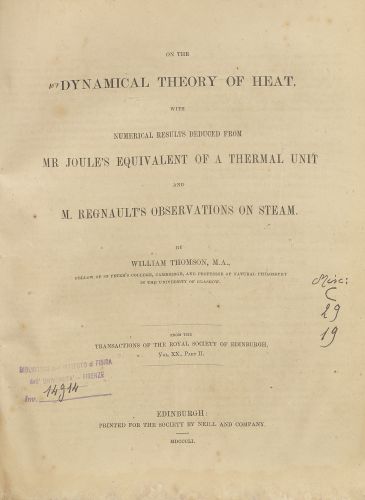Error
On the dynamical theory of heat with numerical results deduced from Mr. Joule’s equivalent of a thermal unit and M. Regnault’s observations on steam
William Thomson (1824-1907), the future Lord Kelvin, introduces his own formulation of the second principle of thermodynamics in the memoir On the dynamical theory of heat, reprinted several times since 1852. As in the case of Carnot, Thomson’s statement (page 265, point 12, in italics) also exploits the axiomatic negation of perpetual motion. Point 13 clarifies: “let A and B be two thermo-dynamic engines [...] and let [...] A derive more work from a given quantity of heat than B, when their sources and refrigerators are at the same temperatures, respectively. Then, on account of the condition of complete reversibility [...], B may be worked backwards, and made to restore any quantity of heat to its source, by the expenditure of the amount of work which [...] it would derive from the same quantity of heat. If, therefore, B be [...] made to restore to the source of A [...] as much heat as has been drawn from it during a certain period of the working of A, a smaller amount of work will be spent thus than was gained by the working of A. Hence, if such a series of operations of A forwards and of B backwards be continued, […] there will result a continued production of work without any continued abstraction of heat from the source [...] and [...] there must be more heat abstracted, from the refrigerator by the working of B backwards than is deposited in it by A. […] We should thus have a self-acting machine, capable of drawing heat constantly from a body surrounded by others at a higher temperature, and converting it into mechanical effect. But this is contrary to the axiom.”


